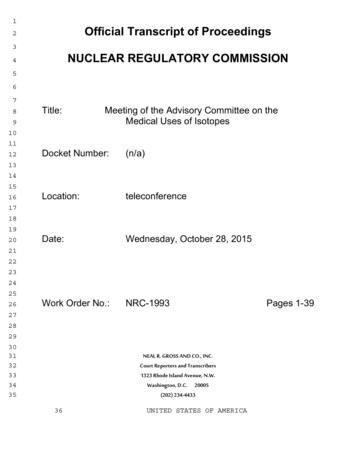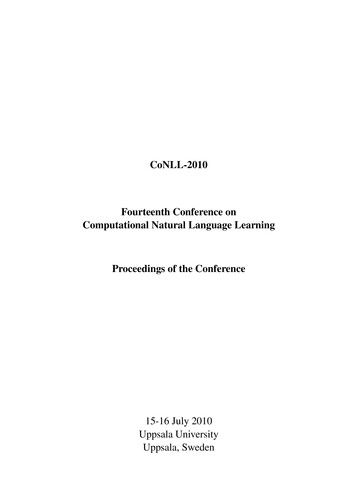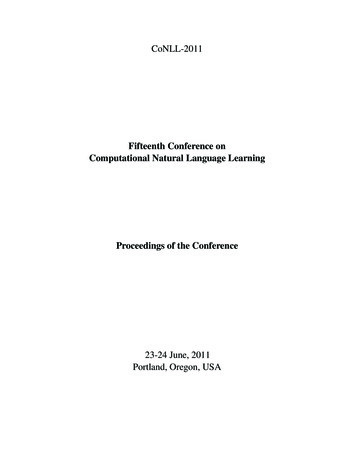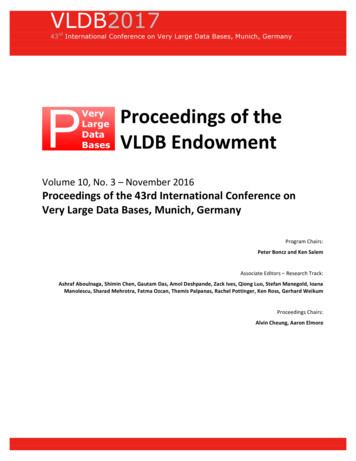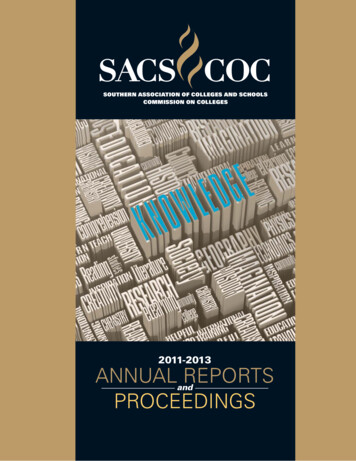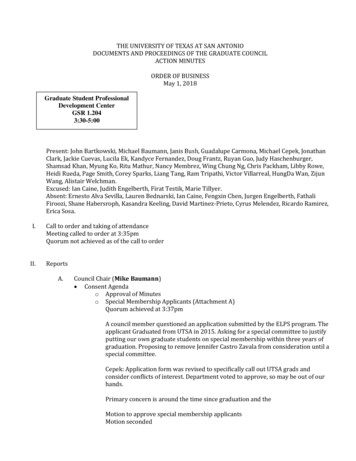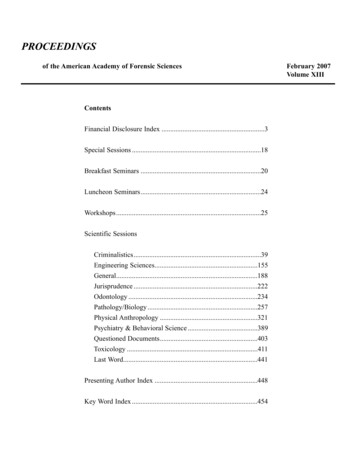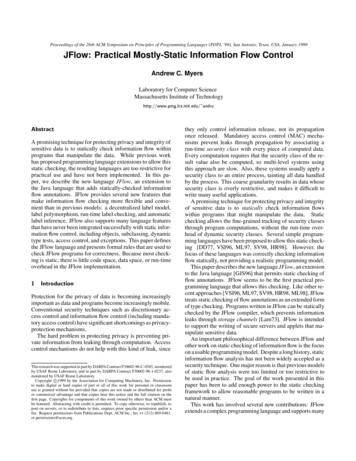
Transcription
ProceedingsW117 - Special Track18th CIB World Building CongressMay 2010 Salford, United KingdomCIB W117 - Performance Measurementin ConstructionCIB Publication 346
CIB WORKING COMMISSIONW117 ‐ PERFORMANCE MEASUREMENT IN CONSTRUCTIONPAPERS AND POSTGRADUATE PAPERS FROM THE SPECIAL TRACKHELD AT THE CIB WORLD BUILDING CONGRESS 2010, 10‐13 MAY 2010THE LOWRY, SALFORD QUAYS, UNITED KINGDOMSelected papers from the Proceedings of the 18th CIB World Building Congress.Proceedings edited by: Professor Peter Barrett, Professor Dilanthi Amaratunga, Dr. RichardHaigh, Dr. Kaushal Keraminiyage and Dr. Chaminda PathirageW117 Special Track Papers (excluding Postgraduate Papers) reviewed by: Dean Kashiwagi,Kenneth Sullivan, Prof. Charles Egbu, Jim Bosshart, Jeroen van de Rijt and Prof. Peter BarrettCIB Publication 346
W117 ‐ PERFORMANCE MEASUREMENT IN CONSTRUCTIONPAPERS AND POSTGRADUATE PAPERS FROM THE SPECIAL TRACKObjectives of W117 include Exploration of the optimal uses of performance information inthe built environment, Create a worldwide resource or "centre" of knowledge of provenmethods for implementing and sustaining performance metrics in an organization andindustry, Create and catalogue performance measurements for many countries by engagingresearchers and practitioners worldwide, to be a forum for innovative, pro‐active, andprogressive clients, industry practitioners, and academics to drive forward the knowledgeand use of performance information and value in construction and related services and as aportal to learn from each other. The group strives to be a bringer of change, based upon 14years of testing in construction performance, to push the industry away fromcommoditization and low performance and into an environment of measurement and value,to identify and compile a list of experts, documents, case studies, and research on the use ofperformance information in the delivery of construction in each major country or area of theworld, to highlight the use and impact of performance measurement in each country in botha CIB commissioned and sponsored journal and a CIB "living document" to allow clients,professionals, contractors, and researchers to quickly identify experts and their work withperformance information around the world and to document, create, and implementperformance information to minimize construction risk.
CONTENTSPapersMeasuring and Improving U.S. Construction ProductivityChapman, R.E. Butry, D.T. Huang, A.L.1Stars and Stragglers in Construction IndustryHoltackers, D. van der Vlist, A.13Industry‐Specific Performance Benchmarking: Pharmaceutical Construction ProjectsHwang, B.22Guidelines for the Development of Benchmarking Collaborative Process Aiming theImplementation of Improvements in Construction CompaniesCosta, D.B. Formoso, C.T.38Benchmarking ‐ a Tool for Judgment or Improvement?Rasmussen, G.M.G.54ELODIE ‐ A Tool for the Environmental Assessment of BuildingsChevalier, J. Lebert, A. Schiopu, N. Alirol, O. Ravel, P. Hans, J. Chevalier, J.L. Ciuti, E.67Developing Indicators for Transparency and International Benchmarking in Constructionand Real Estate IndustryPorkka, J. Huovila, P. Bertelsen, N.H. Haugbolle, K.78Performance of Manual Condition Surveys Using Inter‐Rater Agreement MeasurementsBogus, S.M. Migliaccio, G.C. Cordova, A.A.90Multi‐Variate Project Evaluation Technique for Building ConstructionCha, H. Kim, K. Shin, D. Kim, K.102Reducing Risks with the Performance Information Procurement System (PIPS) inFinnish Construction Management ProjectsKruus, M. Lehtiranta, L. Kiiras, J.112Procurement of Property Management Services in Anthem, AZ (IMT Case Study inDecision Making)Sullivan, K. Carey, B. Lines, B. Kashiwagi, D.124A New Project Management ModelKashiwagi, D. Kashiwagi, J. Sullivan, K.135US Department of Defence Procurement Systems Approaching Best ValueSullivan, K. Cowley, L. Kashiwagi, D.149The Design‐Construction Industry Needs to Move to Best Value (a Survey of A/E/CProfessionals)Child, G. Kashiwagi, D. Sullivan, K.163
Best Value at the Directorate‐General for Public Works and Water Management in theNetherlandsvan de Rijt, J. Witteveen, W. Vis, C. Santema, S.177Postgraduate PapersBarriers of TQM Implementation in Libyan IndustriesShibani, A.189Post Occupancy Evaluation Practices: A Procedural Model for a Successful FeedbackMastor, S.H. Ibrahim, N.200Simplified Indices Assessing Building Envelope's Dynamic Thermal Performance:A SurveyFerrari, S. Zanotto, V.211The Relationship Between Human Resource Practices and Organizational Performancein the Chinese Construction EnterprisesZhai, X. Liu, A.221Evaluation of the Thermal Behaviour of Dwellings: U‐Values ComparisonPereira, S. Paiva, A.233Developing a Conceptual Model for Measuring the Satisfaction Levels of MalaysianContractorsMasrom, M.A.N. Skitmore, M.245Building Project Performance Evaluation ModelWadugodapitiya, R. R. M. M. K. Sandanayake, Y. G. Thurairajah, N.258Trust Yourself: A Doubting Thomas Perspective on Building ResearchNigra, M.270Implementation of Total Quality Manatement (TQM) in Libyan Construction Industry(LCI)Shibani, A. Soetanto, R. Ganjian, E.279Australian Construction KPIsFurneaux, C. Hampson, K. Scuderi, P. Kajewski, S.291Current Performance Measurement Practices: Studies in the United Kingdom (UK) andMalaysiaLatiffi, A.A. Carrillo, P. Ruikar, K. Anumba, C.J.303CIB Brochure316Disclaimer318
Measuring and Improving U.S. ConstructionProductivityChapman, R.E.Office of Applied Economics, Building and Fire Research Laboratory, National Institute of Standardsand Technology(email: robert.chapman@nist.gov)Butry, D.TOffice of Applied Economics, Building and Fire Research Laboratory, National Institute of Standardsand Technology(email: david.butry@nist.gov)Huang, A.L.Office of Applied Economics, Building and Fire Research Laboratory, National Institute of Standardsand Technology(email: allison.huang@nist.gov)AbstractAlthough the construction industry is a major component of the U.S. economy, it has experienced aprolonged period of decline in productivity. Due to the critical lack of measurement methods,however, the magnitude of the productivity problem in the U.S. construction industry is largelyunknown. To address these deficiencies, efforts are underway that focus on the measurement ofconstruction productivity at three levels: task, project, and industry. We discuss how such measurescan be developed, how they are related to the use of information and automation technologies andconstruction processes over the life of the project, and how to build on several ongoing collaborativeefforts aimed at improving the efficiency, competitiveness, and innovation of the U.S. constructionindustry. We identify and prioritize activities that have the greatest potential for improving theproductivity of the U.S. construction industry over the next 20 years. These activities include, but arenot limited to, interoperable technology applications via building information modelling (BIM) andeffective performance measurement to drive efficiency and support innovation. The paper concludeswith a vision for the future built around a suite of standards for measuring task and project-levelproductivity, a database of task and project-level metrics, guidelines for efficient use of BIM andmodularization techniques, and industry-level metrics. Leaders in the U.S. construction industry areaware of the successes and benefits that have accrued from the investments in measuring andmonitoring construction safety and can envision the potential for similar improvements inconstruction productivity.Keywords: building economics, construction, economic analysis, information technology, laborproductivity, metrics, performance measurement, productivity1
1. Construction: an engine for economic growthConstruction is an engine of growth for the U.S. economy. Investment in plant and facilities, in theform of construction activity, provides the basis for the production of products and the delivery ofservices. Investment in infrastructure promotes the smooth flow of goods and services and themovement of individuals. Investment in housing accommodates new households and allows existinghouseholds to expand or improve their housing. It is clear that construction activities affect nearlyevery aspect of the U.S. economy and that the industry is vital to the continued growth of the U.S.economy.In 2008, the construction industry’s contribution to gross domestic product (GDP) was 582 billion,or 4.1 % of GDP (Bureau of Economic Analysis (BEA), 2009). In 2008, the value of construction putin place was 1072 billion (Census Bureau, 2009). Construction also has a major impact on U.S.employment. In 2008, 11.0 million persons were employed in the construction industry (Bureau ofLabor Statistics (BLS), 2009). This translates into 7.6 % of the total U.S. workforce. Thecomposition of the construction workforce differs from much of the U.S. workforce due to the largenumber of self-employed workers (sole proprietorships and partnerships). Within the constructionindustry, there are 1.8 million self-employed workers. The large number of self-employed workersboth reduces the size of the average firm and increases fragmentation within the construction industry,where 79 % of construction establishments with employees have fewer than 10 employees (CensusBureau, 2002a and 2002b). Both factors complicate the adoption of new technologies and practices.Construction employment is affected by both the weather and the business cycle. Thus, year-to-yearchanges in employment can be substantial, resulting in layoffs and hiring surges. The cyclical natureof construction employment produces shortages in many highly-skilled trades. These shortagesadversely impact productivity in the construction industry. Finally, declining constructionproductivity is exacerbated by the influx of unskilled labor from abroad, many of whom find their firstemployment opportunity in the construction industry.2. Productivity and competitivenessGiven the large impact of construction on the U.S. macroeconomic objectives, effective constructionresearch becomes critical to the economy. Key drivers for change in construction research aresustainability and environmental security; competition due to globalization and offshoring;infrastructure renewal; and information technology. The problem is that the U.S. constructionindustry invests little in research relative to its significant GDP contribution to the economy. Alandmark study co-sponsored by the Civil Engineering Research Foundation (CERF) and the NationalScience Foundation (NSF) involved a nationwide survey of civil engineering-related research anddevelopment (R&D). The study, later published by CERF (1994), is especially noteworthy because itincludes R&D associated with each of the key construction industry stakeholders. The CERF studyreported that all key construction industry stakeholders combined invested in R&D at a rate thatcorresponds to only 0.5 % of the value of construction put in place. This translates into approximately 5.4 billion in 2008. A recently published NSF study covering companies performing industrial R&Dprovides a useful contrast (NSF, 2009). Private sector R&D investments in manufacturing totaled2
nearly 167 billion in 2007. Underinvesting reduces the potential for research-inspired innovationsthat contribute to substantial national benefits—namely constructed facilities that are more user andenvironmentally friendly, affordable, productive, and that are easier, faster, and more life-cycle costeffective to build, operate, and maintain. Given the impact of construction spending on the U.S.economy’s health, construction research becomes a critical variable in generating economic growth.A recent article by Teicholz (2004) highlights the magnitude of the U.S. construction industry’sperceived decline in productivity. As measured by constant contract dollars of new construction workper field work hour, labor productivity in the construction industry has trended downward over thepast 40 years at an average compound rate of -0.6 % per year. That is, construction projects haverequired significantly more field work hours per constant dollar of contract. This is particularlyalarming when compared to the increasing labor productivity in all non-farm industries, which hastrended upward at an average compound rate of 1.8 % per year. In other words, the constructionindustry seriously lags other industries in developing labor saving ideas and in finding ways tosubstitute equipment for labor. Teicholz reiterates the points noted earlier for their adverse impact onconstruction labor productivity, namely the lack of R&D spending and fragmentation within theindustry. He also notes that despite the fact that there has been a significant adoption of newinformation technology by the construction industry over the past 35 years, these applications tend torun in a stand-alone mode that does not permit improved collaboration by the project team.It should be noted that not everyone in the construction industry agrees with Teicholz’s assessment.For example, Young and Bernstein (2006), in their McGraw Hill SmartMarket Report, contend thatthe U.S. construction industry is making productivity improvements through innovation with newtechnologies, processes, and services. Teicholz asserts, however, that a fragmented market with verysmall players makes application of these innovations less frequent than desired for a healthy increasein industry productivity. Another reason Teicholz finds declining productivity is that it focuses onfield work. For example, many of the improvements in construction productivity in the oil and gasindustries stem from the use of offsite fabrication facilities, where component production is wellcontrolled and highly-automated (Construction Users Roundtable, 2007). The debate about whetherconstruction productivity is declining, holding its own, or increasing c
Construction: an engine for economic growth . Construction is an engine of growth for the U.S. economy. Investment in plant and facilities, in the form of construction activity, provides the basis for the production of products and the delivery of services. Investment in infrastructure promotes the smooth flow of goods and services and the
